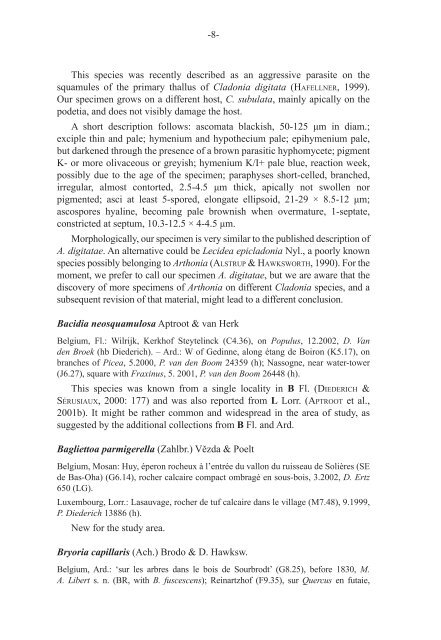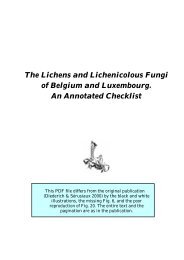LEJEUNIA - Lichens of Belgium, Luxembourg and northern France
LEJEUNIA - Lichens of Belgium, Luxembourg and northern France
LEJEUNIA - Lichens of Belgium, Luxembourg and northern France
You also want an ePaper? Increase the reach of your titles
YUMPU automatically turns print PDFs into web optimized ePapers that Google loves.
-8-<br />
This species was recently described as an aggressive parasite on the<br />
squamules <strong>of</strong> the primary thallus <strong>of</strong> Cladonia digitata (HAFELLNER, 1999).<br />
Our specimen grows on a different host, C. subulata, mainly apically on the<br />
podetia, <strong>and</strong> does not visibly damage the host.<br />
A short description follows: ascomata blackish, 50-125 μm in diam.;<br />
exciple thin <strong>and</strong> pale; hymenium <strong>and</strong> hypothecium pale; epihymenium pale,<br />
but darkened through the presence <strong>of</strong> a brown parasitic hyphomycete; pigment<br />
K- or more olivaceous or greyish; hymenium K/I+ pale blue, reaction week,<br />
possibly due to the age <strong>of</strong> the specimen; paraphyses short-celled, branched,<br />
irregular, almost contorted, 2.5-4.5 μm thick, apically not swollen nor<br />
pigmented; asci at least 5-spored, elongate ellipsoid, 21-29 × 8.5-12 μm;<br />
ascospores hyaline, becoming pale brownish when overmature, 1-septate,<br />
constricted at septum, 10.3-12.5 × 4-4.5 μm.<br />
Morphologically, our specimen is very similar to the published description <strong>of</strong><br />
A. digitatae. An alternative could be Lecidea epicladonia Nyl., a poorly known<br />
species possibly belonging to Arthonia (ALSTRUP & HAWKSWORTH, 1990). For the<br />
moment, we prefer to call our specimen A. digitatae, but we are aware that the<br />
discovery <strong>of</strong> more specimens <strong>of</strong> Arthonia on different Cladonia species, <strong>and</strong> a<br />
subsequent revision <strong>of</strong> that material, might lead to a different conclusion.<br />
Bacidia neosquamulosa Aptroot & van Herk<br />
<strong>Belgium</strong>, Fl.: Wilrijk, Kerkh<strong>of</strong> Steytelinck (C4.36), on Populus, 12.2002, D. Van<br />
den Broek (hb Diederich). – Ard.: W <strong>of</strong> Gedinne, along étang de Boiron (K5.17), on<br />
branches <strong>of</strong> Picea, 5.2000, P. van den Boom 24359 (h); Nassogne, near water-tower<br />
(J6.27), square with Fraxinus, 5. 2001, P. van den Boom 26448 (h).<br />
This species was known from a single locality in B Fl. (DIEDERICH &<br />
SÉRUSIAUX, 2000: 177) <strong>and</strong> was also reported from L Lorr. (APTROOT et al.,<br />
2001b). It might be rather common <strong>and</strong> widespread in the area <strong>of</strong> study, as<br />
suggested by the additional collections from B Fl. <strong>and</strong> Ard.<br />
Bagliettoa parmigerella (Zahlbr.) Vězda & Poelt<br />
<strong>Belgium</strong>, Mosan: Huy, éperon rocheux à l’entrée du vallon du ruisseau de Solières (SE<br />
de Bas-Oha) (G6.14), rocher calcaire compact ombragé en sous-bois, 3.2002, D. Ertz<br />
650 (LG).<br />
<strong>Luxembourg</strong>, Lorr.: Lasauvage, rocher de tuf calcaire dans le village (M7.48), 9.1999,<br />
P. Diederich 13886 (h).<br />
New for the study area.<br />
Bryoria capillaris (Ach.) Brodo & D. Hawksw.<br />
<strong>Belgium</strong>, Ard.: ‘sur les arbres dans le bois de Sourbrodt’ (G8.25), before 1830, M.<br />
A. Libert s. n. (BR, with B. fuscescens); Reinartzh<strong>of</strong> (F9.35), sur Quercus en futaie,





